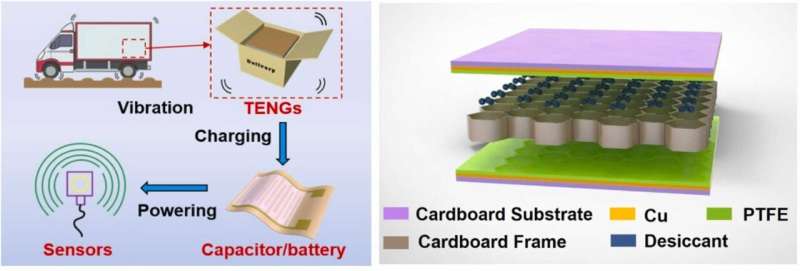This article has been reviewed according to Science X's editorial process and policies. Editors have highlighted the following attributes while ensuring the content's credibility:
fact-checked
peer-reviewed publication
trusted source
proofread
Research team begins designing a perishable food 'smart packaging' system for transport

Case Western Reserve University researchers are leading the development of a "smart packaging" system to monitor temperature fluctuations, moisture changes and pathogens in perishable food products during transportation.
Their energy-efficient approach may offer a more cost-effective supply chain for distributors, savings for food producers and higher quality food for consumers.
"If this works well, everyone stands to benefit," said Chanyong (Chase) Cao, an assistant professor of mechanical and aerospace engineering and electrical, computer and systems engineering at Case Western Reserve, who is leading the research team. "About one-third of all food produced for human consumption gets lost or wasted—roughly 1.3 billion tons of food each year. Our solution could significantly reduce spoilage, cut costs and ensure food safety."
The team's research was recently published online in the journal Nano Energy.
Self-powered monitoring
A central feature of their system is a small, self-powered monitoring device consisting of flexible sensors and an energy harvester that uses desiccants—the small packets of silica gel pellets found in packaging to absorb moisture—for harnessing and storing ambient energy. In this system, the energy is generated from the vibrations of the food delivery truck itself.
This energy powers a real-time monitoring system that would provide food producers and transport staff with digital data about temperature, moisture and spoilage conditions of the packaged food.
To make this happen, Cao and his team came up with what they call a desiccant-based triboelectric nanogenerator (D-TENG) to extend the serving time of the sensing system.
Triboelectric nanogenerators are any energy harvesting device that converts mechanical energy—often between two objects sliding against each other—into electricity.
The team designed a paperboard-based honeycomb frame to store the desiccant materials—now also used to create electricity as they bounce around inside the honeycomb.
Cao said that while some modern transport companies already use sensors to record temperature, humidity and carbon dioxide, the traditional batteries required to operate those systems are costly, heavy and can contribute to environmental pollution. Many of those systems don't provide real-time data to detect food spoilage, Cao said. Existing small, portable systems can only detect environment conditions within a very limited period.
Potential reach, next steps
The team's approach aligns with the World Bank's proposed solutions to food waste, which include better technology for storing and keeping perishables fresh in the supply chain. While Cao and his team haven't addressed how to better cool perishable food in transit in this project, they would be tackling the first task of identifying when and what might go wrong.
The team is now assembling a functioning prototype; Cao said he hopes to scale up production and begin marketing it over the next five years.
Cao and his team are focusing on detecting and preventing food spoilage, but he believes the technology could also provide benefits for shipping vaccines. The system could provide companies and government agencies accurate real-time information about the temperature of those critical shipments.
More information: Yaokun Pang et al, Toward self-powered integrated smart packaging system − Desiccant-based triboelectric nanogenerators, Nano Energy (2023). DOI: 10.1016/j.nanoen.2023.108659
Journal information: Nano Energy
Provided by Case Western Reserve University



















